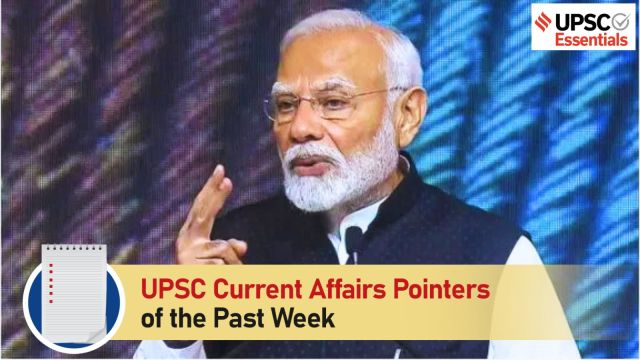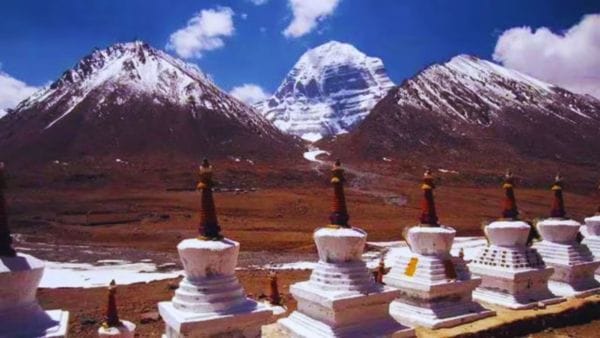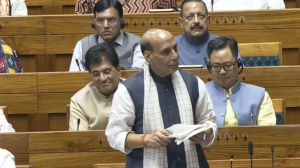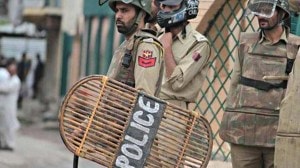UPSC Current Affairs Pointers of the past week | April 21 to April 27, 2025
National Civil Services Day 2025, Indus Waters Treaty, FatBoyPanel, Persona Non Grata, .bank.in and more — Here are some must-read current affairs tidbits for your prelims and mains preparation that you shouldn't miss for UPSC, state PSCs, and other competitive examinations. You can also test your knowledge by solving the MCQs.
 PM Modi addressed civil servants on National Civil Services Day. (File image)
PM Modi addressed civil servants on National Civil Services Day. (File image)UPSC Current Affairs Pointers brings you essential current affairs of the past week, every Monday, to aid you in your Prelims and Mains preparation of UPSC, State PCS, and other competitive examinations.
Days and Events
— Prime Minister Narendra Modi addressed the Nation’s Civil Servants on 17th Civil Services Day 2025 on April 21, 2025. ‘Holistic Development of India’ was the theme of this year’s Civil Services Day.
— Every year on April 21, the Government of India commemorates National Civil Services Day to acknowledge and celebrate the exceptional efforts of our civil servants engaged in public service, the backbone of the nation’s administration, as they devote themselves to the cause of citizens.
— On this day, the Prime Minister of India honours civil service officers with the PM Awards for Excellence in Public Administration in recognition of their outstanding service and contributions.
— This national observance was first marked on April 21, 2006. The day’s history can be traced back to the time when the first Home Minister of Independent India, Sardar Vallabhbhai Patel, addressed the probationers of Administrative Services Officers at Metcalf House in Delhi, referring to the civil servants as the “steel frame of India” on April 21, 1947.
Click here to read more about the key historical moments in the evolution of India’s Civil Services.
— The first World Audio Visual & Entertainment Summit, known by the acronym WAVES, will be a key forum for promoting discussions, collaboration, and innovation in the Media and Entertainment industry.
— The event will bring together industry leaders, stakeholders, and innovators to discuss prospects, challenges, promote trade to India, and influence the sector’s future.
— It will be hosted by the Ministry of Information and Broadcasting, Government of India in Mumbai, Maharashtra, from May 1 to 4, 2025.
Schemes and Missions
— The Expenditure Finance Committee under the Ministry of Finance, which appraises government schemes, has recommended Rs 1.51 lakh crore as the Centre’s share for the Jal Jeevan Mission (JJM) till 2028. This is about 46 per cent lower than what was sought by the Ministry of Jal Shakti.
— Prime Minister Narendra Modi announced Jal Jeevan Mission (JJM) to provide potable water to rural households in his Independence Day Speech of 2019.
— The aim was to provide potable water in adequate quantity, i.e. 55 litre per capita per day (lpcd), of prescribed quality, i.e. BIS Standard of IS: 10500, on a regular basis to every rural household by 2024.
— The fund sharing pattern was fixed at 90:10 for Himalayan and North-Eastern States and 50:50 for other states.
Click here to read more on Jal Jeevan Mission
Economy
— To combat the increasing number of digital payment frauds, the Reserve Bank of India (RBI) has decided to operationalise the ‘. bank.in’ domain for banks.
— The ‘.in’ is India’s Country Code Top Level domain (ccTLD). This exclusive internet domain for domestic banks will minimise cyber security threats and will help in strengthening trust in the country’s digital banking and payment services. The RBI has asked banks to migrate to .bank.in domain by October 31, 2025.
— A domain name is used to find websites. It is a unique and easy-to-remember address to access websites on the internet.
Click here to read more about the ‘.bank.in’ domain for banks.
International Relations
— A day after India took a series of steps against Pakistan in response to the terror attack in Pahalgam, the neighbouring country Thursday said it “shall exercise the right to hold all bilateral agreements with India, including but not limited to Simla Agreement, in abeyance”.
— The agreement was signed by Indian Prime Minister Indira Gandhi and Pakistani President Zulfikar Ali Bhutto after the 1971 war, and was considered a significant breakthrough.
— An official copy of the agreement published by the Ministry of External Affairs says it sought to reverse the consequences of the 1971 War.
— The agreement “was a comprehensive blueprint for good neighbourly relations between India and Pakistan”, with both countries undertaking “to abjure conflict and confrontation which had marred relations in the past, and to work towards the establishment of durable peace, friendship and cooperation”.
— “The principles and purposes of the Charter of the United Nations shall govern the relations between the two countries”, the agreement said, referring to the founding document of the United Nations.
— “Pending the final settlement of any of the problems between the two countries, neither side shall unilaterally alter the situation and both shall prevent… any acts detrimental to the maintenance of peaceful and harmonious relations,” the agreement added.
— The countries vowed to withdraw their troops to their side of the border, and to “respect each other’s national unity, territorial integrity, political independence and sovereign equality”. They also pledged to take steps for resuming “communications, postal, telegraphic, sea, land including border posts, and air links including overflights”.
— The Line of Control in Jammu and Kashmir resulting from the ceasefire of December 17, 1971, would “be respected by both sides without prejudice to the recognized position of either side”, the two countries said. “Neither side shall seek to alter it unilaterally, irrespective of mutual differences and legal interpretations.”
— Following more than three years of arduous negotiations, member states of the World Health Organization (WHO) last week agreed on a draft of a legally binding treaty designed to tackle future pandemics better. The deal is expected to be ratified at the World Health Assembly in May.
— The pandemic treaty, which was agreed upon without the United States, is the only the second legally binding accord in the WHO’s 75-year history, the first being the 2003 tobacco control treaty.
— The negotiations for a global pandemic treaty began in December 2021, at a time when the Omicron variant of SARS-CoV-2 was spreading across the world and producing a massive new surge of COVID-19. By then, countries that were manufacturing COVID-19 vaccines had hoarded millions of doses, leaving those with no vaccine plants often with no access to the shots.
— A 2022 study published by the journal Nature revealed that more than one million lives could have been saved if COVID-19 vaccines had been shared more equitably with lower-income countries — the virus had claimed more than seven million lives across the world.
— In a bid to prevent loss of human life, and disruption to households and societies at large – as it happened due to the COVID-19 pandemic — during future pandemics, WHO member states got together and began to iron out a treaty.
— One of the key elements of the draft agreement is a “pathogen access and benefit sharing” system, which gives pharmaceutical companies access to scientific data such as pathogen samples and genomic sequences in return for more equitable sharing of drugs, vaccines and diagnostics during a pandemic, according to a report in Nature.
— The draft treaty says participating manufacturers will have to allocate 10% of their production of vaccines, therapeutics and diagnostics to the WHO. Another 10% will then be supplied at “affordable prices”.
— Also, member states should “promote and otherwise facilitate or incentivise” the exchange of technology and know-how to help manufacturers in developing nations make their own drugs and vaccines, the draft agreement says.
— Countries also need to develop national policies for putting conditions on research into drugs and vaccines that they fund — given either to universities or companies — to guarantee “timely and equitable access” to resulting drugs or diagnostics during pandemics.
— India is set to sign a deal on procuring 26 Rafale-Marine (Rafale-M) fighter jets for the Indian Navy from France on Monday, that is estimated to cost around `63,000 crore, sources have said. The government-to-government deal is being signed by the Defence ministers remotely.
— Sources said that the Rafale-M jets include 22 single-seater jets that can operate from aircraft carriers and four twin-seater trainer jets, which are not carrier-compatible. The delivery of the jets will begin in 2028-29 after the contract is signed and is expected to be completed by 2031-32.
— The Rafale-M fighter jets would come along with associated ancillary equipment, weapons, simulator, spares, documentation, crew training and logistic support. Their procurement from the French Government is on an Inter-Governmental Agreement (IGA) basis.
— Four of these 26 aircraft are likely to be the trainer version. With the MiG-29 Ks slated to be phased out in the next few years, procuring the jets is an interim arrangement for the Navy’s aircraft carriers—INS Vikramaditya (procured from Russia) and indigenously-built INS Vikrant—till it acquires the indigenous Twin Engine Deck-Based Fighter which is currently under development by Aeronautical Development Agency under the DRDO.
— For the Navy’s fighter jet deal, the competition was between Boeing’s F/A-18 E/F Super Hornet and Dassault Aviation’s Rafale-M. While both fighters had met the Navy’s requirements, the Rafale-M had common spares and support as the Rafale jets operated by the Indian Air Force.
— The Rafale jets, which were acquired after the Balakot aerial strike, have added to the Indian Air Force’s firepower. The 36 Rafael fighter jets have been stationed in India’s strategic air bases bordering Pakistan and China. The two sides have always prioritised co-production, co-development of military hardware with a focus on India’s self-reliance goals.
— Harvard University and the Trump administration have locked horns over allegations by the latter that the university has failed to contain anti-Semitism.
— Harvard filed a lawsuit on Monday (April 21) against the administration seeking to end the federal funding freeze on the university. Effectively, access to $2.2 billion in funding has been cut off, while the administration is considering revoking an additional $1 billion in grants.
— The International Holocaust Remembrance Alliance, an intergovernmental organisation formed in 1998, provided the following working definition of anti-Semitism: “Antisemitism is a certain perception of Jews, which may be expressed as hatred toward Jews. Rhetorical and physical manifestations of antisemitism are directed toward Jewish or non-Jewish individuals and/or their property, toward Jewish community institutions and religious facilities.”
— However, the term itself is a misnomer as Semitic designates a language group, not a race. In a linguistic sense, the term could describe prejudice against speakers of the Semitic languages (including Arabs and Ethiopians).
— A primary reason for anti-Semitism being contentious is the enduring legacy of Nazism, which converted anti-Semitism into an institutional attack on Jewish people, ranging from a boycott of Jewish products and social ostracisation and culminating in the Holocaust.
— Following the attack on Israel by the Palestinian militant group, Hamas, on October 7, 2023, and the resulting Israeli military onslaught into Palestine that has ensued since then, anti-Semitism has been used by detractors in the context of pro-Palestine protests. The Trump administration has adopted this understanding in pursuing universities and sites of such protests to shut them down.
— This year marks the 70th anniversary of the first Asia-Africa summit, which took place in Bandung, Indonesia from April 18 to 24, 1955.
— Twenty-nine newly independent Asian and African countries met in what was a historical gathering of the leaders of the developing south, recently freed from the devastation brought upon their countries by the ravages of colonial rule.
— The countries signed a 10-point declaration or that co-opted the Five Principles or Panchsheel. A 10-point “declaration on promotion of world peace and cooperation”, called Dasasila Bandung (Bandung’s Ten Principles, or Bandung Spirit, or Bandung Declaration). The conference served as a precursor to the Non-Aligned Movement (NAM).
Click here to read more about the Bandung Conference
—Persona non grata is a Latin phrase which means “unwelcome person.” It has a specific meaning in diplomacy, referring to a diplomat or foreign person whose entry or presence in a certain country has been prohibited by that country.
—The designation received diplomatic meaning at the 1961 Vienna Convention on Diplomatic Relations, which lays the ground rules for how diplomats are to be treated, including in relation to their rights and privileges in host countries. Article 9 of the treaty mentions that a country can declare any member of a diplomatic staff persona non grata “at any time and without having to explain its decision.”
Click here to read more on 1961 Vienna Convention on Diplomatic Relations
— A day after the attack on tourists in Pahalgam, in which Pakistani terrorists took the lives of 26 people, Foreign Secretary Vikram Misri said on Wednesday (April 23) evening, “The Indus Waters Treaty of 1960 will be held in abeyance with immediate effect, until Pakistan credibly and irrevocably abjures its support for cross-border terrorism,” .
— The IWT was signed in Karachi on September 19, 1960, following nine years of negotiations between India and Pakistan. The Treaty has 12 Articles and 8 Annexures (from A to H).
— According to the provisions of the Treaty, all the water of the “Eastern Rivers” of the Indus system — Sutlej, Beas and Ravi — shall be available for the “unrestricted use” of India. Pakistan shall receive water from the “Western Rivers” — Indus, Jhelum, and Chenab.
— The Indus Waters Treaty lacks an exit clause, meaning neither India nor Pakistan can legally abrogate it unilaterally. The Treaty has no end date, and any modification requires the consent of both parties.
— But while the Treaty cannot be exited, it does contain a dispute resolution mechanism: Article IX, along with Annexures F and G, lays out procedures for raising grievances — first before the Permanent Indus Commission, then a neutral expert, and eventually, a forum of arbitrators.

Click here to read more about the Indus Waters Treaty of 1960.
Environment
— Three people were killed after torrential rainfall and hail in the Ramban tehsil of Jammu and Kashmir on Sunday (April 20) morning. The Ramban district administration, Udhampur MP and Union Minister Jitendra Singh, and the J&K Office of Chief Minister all posted information about the events on social media, using terms like flash flood, landslide, and cloudburst.
— Cloudburst : Rainfall of 10 cm or more in an hour, over a roughly 10 km x 10 km area. They are more common in hilly areas because of a phenomenon called ‘orographic lift’, which basically means warm air rising up the side of a mountain. As warm air ‘climbs’ a mountain, it expands because of the low pressure above. The expanding air cools, releasing the moisture it was holding as rain. But if more and more warm air keeps rising, it prevents that rain, till a large amount of rain builds up and bursts out in a massive shower all at once. Because cloudbursts happen in localised areas ( over a roughly 10 km x 10 km area), they are difficult to capture accurately. The sudden rain released by a cloudburst can quickly overwhelm drainage systems and lead to flash floods and landslides.
— Flash floods: It happens quickly, when a lot of rain suddenly enters into the drainage systems (waterbodies, drains), and water overflows. Flash floods are again more common in hills, because rocky terrain does not absorb water very well. While river floods, the kind normally seen in plains, last longer and cause more damage to property, the sudden flash floods are more likely to lead to loss of life.
— Landslide: It is a portion of ‘land’ coming loose and sliding — rocks and soil slipping down a mountain, for example. As the British Geological Survey’s website says, “When the force of gravity acting on a slope exceeds the resisting forces of a slope, the slope will fail and a landslide occurs…adding water to the material on a slope makes a landslide more likely to happen. This is because water adds weight, lowers the strength of the material and reduces friction, making it easier for material to move downslope.” A lot of water gushing down just speeds up this process. Landslides can crush people and animals under the debris, make roads unmotorable, and a lot of debris falling into a water body can cause floods.
Science and Technology
— The Axiom Mission 4 will see India, Poland, and Hungary’s first government-sponsored human spaceflight in more than 40 years next month. With the addition of an American astronaut, the four-person crew will conduct various studies and activities in Space while docked at the International Space Station (ISS) for two weeks.
— Group Captain Shubhanshu Shukla, a distinguished pilot in the Indian Air Force (IAF), has been selected for the Indian Space Research Organisation (ISRO). Among the studies set to be carried out is ISRO’s Voyager Tardigrades project, which will investigate the revival, survival, and reproduction of tardigrades – creatures that have long fascinated scientists.
— “Water bear” is a bit of a misnomer for these microscopic eight-legged animals, which don’t just live in water. Measuring between 0.1 and 0.5 millimetres, they are known for surviving the most dire physical environments, from arid regions to high up in the Himalayas. They can also go without food or water for up to years, although their average lifespan is not more than a decade.
— This incredible resilience is why the animals have been on Earth for around 600 million years, and will likely withstand any major changes to the Earth’s climate in the near future as well.
— Scientists are still trying to understand the complex mechanisms involved, but one part of the equation is a process resembling hibernation. For instance, amid a lack of water, they can theoretically shut down all the life processes happening inside them.
— They are the only known animals capable of surviving even in the cold vacuum of Space. In 2007, a crewless Russian capsule on a European Space Agency (ESA) mission exposed some 3,000 tardigrades to the vacuum of space for 10 days, and they were left out there in low-Earth orbit (altitude under 2,000 km). Over two-thirds of the animals survived the mission and even gave birth to offspring upon returning to Earth.
— The ISRO project will examine the revival of dormant tardigrades, count the number of eggs laid and hatched during a mission, and compare the gene expression patterns of spaceflown vs. ground control populations. The research seeks to identify molecular mechanisms of resilience, potentially furthering understanding about the limits of life in extreme environments.
— This knowledge could inform future space exploration and help develop biotechnology applications on Earth, at a time when governments and private companies are lining up to carry out Space missions.
— FatBoyPanel is a mobile-first banking trojan that has been discovered across nearly 900 different applications, primarily targeting Indian users.
— The attack begins with social engineering: scammers pose as officials or trusted entities and approach users via WhatsApp. They then send a malicious APK, encouraging the user to install it. Once installed, the app gains access to sensitive data and steals one-time passwords (OTPs) to execute unauthorised transactions.
— The government has selected Bengaluru-based start-up Sarvam to build the country’s first indigenous artificial intelligence (AI) large language model (LLM) amid waves made by China’s low cost model DeepSeek.
— Sarvam is the first start-up to get approved for sops under India’s ambitious Rs 10,370 crore IndiaAI Mission to build a model.The start-up will receive support from the government in terms of compute resources to build the model from scratch.
— Sarvam’s model will be built, deployed, and optimised in India, using local infrastructure and developed by a new generation of Indian talent. This initiative aims to promote strategic autonomy, accelerate domestic innovation, and secure India’s leadership in AI for the long term, the company said in a press statement.
— The Defence Research and Development Laboratory (DRDL), a unit of DRDO, on Friday conducted a long-duration ground test of an Active Cooled Scramjet Subscale Combustor for over 1,000 seconds at the state-of-the-art Scramjet Connect Test Facility in Hyderabad.
— Scramjets are air-breathing engines capable of sustaining combustion at supersonic speeds without using any moving parts. Hypersonic cruise missiles, a class of advanced weaponry, can travel at speeds greater than five times the speed of sound (over 6,100 km/h) for extended durations, powered by air-breathing engines.
— Air-breathing propulsion systems with supersonic combustion are crucial for sustained high-speed cruise conditions.
— Air Breathing Propulsion offers a technology solution for a low-cost space transportation system. They remove the requirement of oxidisers by utilising ambient air, resulting in a substantially higher payload fraction.
Persons in News
— Former Isro chief K Kasturirangan passed away at 84 on April 25, 2025.
— He who served in ISRO for more than three and a half decades, headed the organisation between 1994 and 2003, a little turbulent time for the space agency a number of international restrictions, including access to cryogenic technology. The restrictions became even tighter after India’s nuclear test in 1998.
— It was during Kasturirangan’s leadership that ISRO embarked on a path of self-reliance and began planning for the big missions like Chandrayaan. Kasturirangan later became a member of the Rajya Sabha and then a member of the erstwhile Planning Commission. He also served the government in a number of other advisory capacities. He either headed or was part of committees that advised the government on a range of issues including higher education, technology, and even environment.
Places in News
— In a significant step towards normalising India-China ties since the border standoff began in 2020, New Delhi announced on Saturday that it will resume the Kailash Mansarovar Yatra from June this year.
 The Kailash-Mansarovar yatra through the Lipulekh pass was closed in 2019 after the outbreak of the Covid-19 pandemic. (Express File)
The Kailash-Mansarovar yatra through the Lipulekh pass was closed in 2019 after the outbreak of the Covid-19 pandemic. (Express File)
— The resumption of the yatra after a gap of five years is an important measure towards rebuilding the trust deficit that emerged since the border standoff in which 20 Indian soldiers were killed in Galwan.
— Lake Mansarovar, known locally as Mapam Yumtso, is a high altitude freshwater lake near Mount Kailash in the Ngari Prefecture of the Tibet Autonomous Region (TAR).

— There are two primary routes to reach Lake Mansarovar from India.
1. Lipulekh Pass Route: Lipulekh pass lies at an altitude of 5,115 metres, on the border between Uttarakhand and TAR, near the trijunction with Nepal.
2. Nathu La Pass Route: Nathu La pass lies at an altitude of 4,310 metres on the border between Sikkim and TAR. It is one of two mountain passes in the region — the other being Jelep La — that have connected Sikkim and Tibet since ancient times.
— Indian Naval Sailing Vessel (INSV) Tarini on Tuesday (April 22) set sail from Cape Town for the final leg of its journey to Goa as part of the second edition of the Navika Sagar Parikrama expedition.
— Two women naval officers, Lieutenant Commander Roopa A and Lieutenant Commander Dilna K, embarked on a historic sailing expedition from Goa on October 2, 2024 to circumnavigate the globe aboard INSV Tarini, without external assistance and solely relying on wind power.
— During the period, the vessel encountered three cyclones while going past Point Nemo, also known as the Oceanic Pole of Inaccessibility. They also navigated the dangerous Drake Passage before passing the Cape Horn.
— This remote oceanic location is located at 48°52.6′S 123°23.6′W, approximately 2,688 kilometres from the nearest land—Ducie Island, part of the Pitcairn Islands, to the north; Motu Nui, one of the Easter Islands, to the northeast; and Maher Island, part of Antarctica, to the south in the southern Pacific Ocean.
Test Your Knowledge
(Note: The best way to remember facts for UPSC and other competitive exams is to recall them through MCQs. Try to solve the following questions on your own.)
(1) With reference to the Indus Waters Treaty (IWT), consider the following statements:
1. The IWT was signed by India and Pakistan in 1960 to determine the distribution of the waters of the Indus and its tributaries.
2. It was signed in Delhi by then Prime Minister Jawaharlal Nehru and then Pakistan President Ayub Khan.
3. Under the IWT, India enjoys “unrestricted use” of the three “Western Rivers” Indus, Chenab, and Jhelum.
How many of the statements given above are correct?
(a) Only one
(b) Only two
(c) All three
(d) None
(2) Consider the following statements:
1. Lipulekh pass lies on the border between Uttarakhand and Tibet Autonomous Region (TAR) near the trijunction with Nepal.
2. Nathu La pass lies on the border between Sikkim and TAR.
Which of the statements given above is/are correct?
(a) 1 only
(b) 2 only
(c) Both 1 and 2
(d) Neither 1 nor 2
(3) India is to execute an agreement with which country to purchase 26 Rafale-Marine (Rafale-M) fighter jets for the Indian Navy?
(a) France
(b) Russia
(c) USA
(d) Germany
|
Answer Key |
| 1. (a) 2. (c) 3. (a) |
Previous Articles
UPSC Current Affairs Pointers of the past week | April 14 to April 20, 2025
UPSC Current Affairs Pointers of the past week | April 7 to April 13, 2025
UPSC Current Affairs Pointers of the past week | March 31 to April 6, 2025
UPSC Current Affairs Pointers of the past week | March 24 to March 30, 2025
For your answers, queries and suggestions write at manas.srivastava@indianexpress.com
Subscribe to our UPSC newsletter. Stay updated with the latest UPSC articles by joining our Telegram channel – IndianExpress UPSC Hub, and follow us on Instagram and X.
🚨 Click Here to read the UPSC Essentials magazine for April 2025. Share your views and suggestions in the comment box or at manas.srivastava@indianexpress.com🚨
Photos



- 01
- 02
- 03
- 04
- 05






























